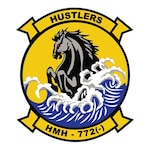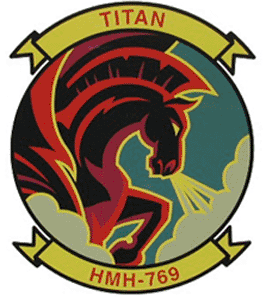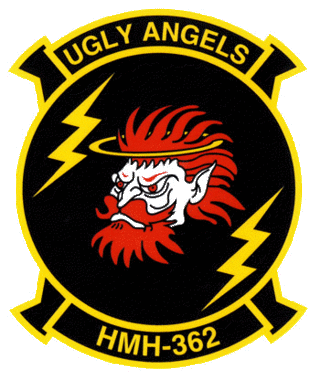
The Sikorsky CH-53E Super Stallion is a heavy lift helicopter operated by the United States military. As the Sikorsky S-80, it was developed from the CH-53 Sea Stallion, mainly by adding a third engine, adding a seventh blade to the main rotor, and canting the tail rotor 20°. It was built by Sikorsky Aircraft for the United States Marine Corps. Developed in the 1970s, it entered service in 1981, and is planned to be in service into the 2030s. It is one of the largest helicopters, and military helicopters in service, and is operated from U.S. Navy ships or from land.

The CH-53 Sea Stallion is an American family of heavy-lift transport helicopters designed and built by the American manufacturer Sikorsky Aircraft. The Sea Stallion was originally developed in response to a request from the United States Navy's Bureau of Naval Weapons made in March 1962 for a replacement for the Sikorsky CH-37 Mojave helicopters flown by the United States Marine Corps (USMC).

Marine Heavy Helicopter Squadron 772 (HMH-772) is a United States Marine Corps helicopter squadron consisting of CH-53E Super Stallion transport helicopters. The squadron, known as the Flying Armadillos with the Radio Callsign "Hustler", is based at McGuire AFB, New Jersey and falls under the command of Marine Aircraft Group 49 (MAG-49) and the 4th Marine Aircraft Wing.

Marine Heavy Helicopter Squadron 769 (HMH-769) was a United States Marine Corps CH-53E helicopter squadron. Nicknamed "Titan", the squadron was based at Edwards Air Force Base in California and fell under the command of Marine Aircraft Group 46 (MAG-46) and the 4th Marine Aircraft Wing. HMH-769 was deactivated on 2 August 2008.

Marine Heavy Helicopter Squadron 361 (HMH-361) is a United States Marine Corps helicopter squadron consisting of CH-53E Super Stallion transport helicopters. The squadron, known as the "Flying Tigers", is based at Marine Corps Air Station Miramar in California, and falls under the command of Marine Aircraft Group 16 (MAG-16) and the 3rd Marine Aircraft Wing.

Marine Heavy Helicopter Squadron 462 (HMH-462) is a United States Marine Corps helicopter squadron operating CH-53E Super Stallion heavy transport helicopters. The squadron, known as the "Heavy Haulers", is based at Marine Corps Air Station Miramar in California and falls under the command of Marine Aircraft Group 16 (MAG-16) and the 3rd Marine Aircraft Wing.

Marine Medium Tiltrotor Squadron 362 (VMM-362) is a United States Marine Corps squadron that operates MV-22 Osprey. The squadron, known as the "Ugly Angels", was reactivated on 17 August 2018 at Marine Corps Air Station Miramar, California.

Marine Heavy Helicopter Squadron 461 (HMH-461) is a United States Marine Corps helicopter squadron consisting of CH-53K King Stallion transport helicopters. The squadron, known as "Ironhorse", is based at Marine Corps Air Station New River in North Carolina and falls under the command of Marine Aircraft Group 29 (MAG-29) and the 2nd Marine Aircraft Wing. With its lineage starting in 1944, HMH-461 is the oldest active Heavy Lift Helicopter Squadron in the Marine Corps.

Marine Heavy Helicopter Squadron 463 (HMH-463) was a United States Marine Corps helicopter squadron consisting of CH-53E Super Stallion transport helicopters. The squadron, also known as "Pegasus", was last based at Marine Corps Air Station Kaneohe Bay in Hawaii and fell under the command of Marine Aircraft Group 24 (MAG-24) and the 1st Marine Aircraft Wing. HMH-463 was decommissioned in April 2022 as part of the Commandant of the Marine Corps Force Design 2030 initiative.

Marine Aircraft Group 41 (MAG-41) is a United States Marine Corps reserve aviation unit based at Naval Air Station Joint Reserve Base Fort Worth, Texas that is currently composed of one F/A-18C squadron, one KC-130J squadron, one C-40 squadron, one Northrop F-5 aggressor squadron based at Marine Corps Air Station Yuma, Arizona, one Marine Light Attack Helicopter Squadron at MCAS Camp Pendleton, one MV-22B squadron based at MCAS Miramar, one aviation logistics squadron and two wing support squadrons with multiple detachments throughout the United States.

Marine Heavy Helicopter Training Squadron 302 (HMHT-302), is a United States Marine Corps helicopter training squadron stationed at Marine Corps Air Station New River, North Carolina. Known as the "Phoenix", HMHT-302 trains newly designated Naval Aviators, conversion pilots, refresher pilots, and enlisted aircrew on the CH-53E Super Stallion and falls under the command of Marine Aircraft Group 29 (MAG-29) and the 2nd Marine Aircraft Wing.

Marine Medium Tiltrotor Squadron 164 (VMM-164), is a United States Marine Corps tiltrotor squadron operating the MV-22B Osprey. Known as the Knightriders, they fall under the command Marine Aircraft Group 39 (MAG-39) and the 3rd Marine Aircraft Wing. They are based at Marine Corps Air Station Camp Pendleton.

The Sikorsky CH-53K King Stallion is a heavy transport helicopter designed and produced by Sikorsky Aircraft. The King Stallion is an evolution of the long running CH-53 series of helicopters which has been in continuous service since 1966, and features three up-rated 7,500 shp (5,590 kW) engines, new composite rotor blades, and a wider aircraft cabin than its predecessors. It is the largest and heaviest helicopter in the U.S. military.

Marine Aircraft Group 49 is a United States Marine Corps Reserve aviation unit based at Joint Base McGuire–Dix–Lakehurst, New Jersey that is currently composed of squadrons that fly the MV-22B, CH-53E, AH-1Z, UH-1Y, UC-35D and UC-12F/W aircraft as well as an Aviation Logistics Squadron and Wing Support Squadron.

Marine Medium Tiltrotor Training Squadron 204 (VMMT-204) is the MV-22 Osprey training squadron of the United States Marine Corps. Known as the "Raptors", the squadron was originally designated Marine Medium Helicopter Training Squadron 204 (HMT-204) to train new MV-22 pilots and was officially redesignated as VMMT-204 on 10 June 1999. They fall under the command of Marine Aircraft Group 26 (MAG-26) and the 2nd Marine Aircraft Wing.

Airborne Mine Countermeasures Weapon Systems Training School (AWSTS) was a United States Navy helicopter training squadron stationed at Naval Station Norfolk, Virginia. AWSTS trained newly commissioned Naval Aviators, conversion pilots, refresher pilots, and enlisted aircrew on the MH-53E Sea Dragon and was a part of Helicopter Sea Combat Wing, Atlantic Fleet (HELSEACOMBATWINGLANT).

Helicopter Combat Support Squadron FOUR (HC-4) was a United States Navy helicopter squadron based at Naval Air Station Norfolk, Virginia. Nicknamed the "Black Stallions", they flew the Sikorsky CH-53E Super Stallion and MH-53E Sea Dragon helicopters.

The United States Marine Corps Aviation (USMCA) is the aircraft arm of the United States Marine Corps. Aviation units within the Marine Corps are assigned to support the Marine Air-Ground Task Force, as the aviation combat element, by providing six functions: assault support, antiair warfare, close air support, electronic warfare, control of aircraft and missiles, and aerial reconnaissance. The Corps operates rotary-wing, tiltrotor, and fixed-wing aircraft mainly to provide transport and close air support to its ground forces. Other aircraft types are also used in a variety of support and special-purpose roles. All Marine Corps aviation falls under the influence of the Deputy Commandant for Aviation, whose job is to advise the Commandant of the Marine Corps in all matters relating to aviation, especially acquisition of new assets, conversions of current aircraft, maintenance, operation, and command.

Helicopter Sea Combat Squadron 2 , also known as the "Fleet Angels", is a helicopter squadron of the United States Navy based at Naval Station Norfolk operating the Sikorsky MH-60S Seahawk. The Fleet Angels are a Fleet Replacement Squadron providing trained MH-60S crew to units on the East Coast.




















